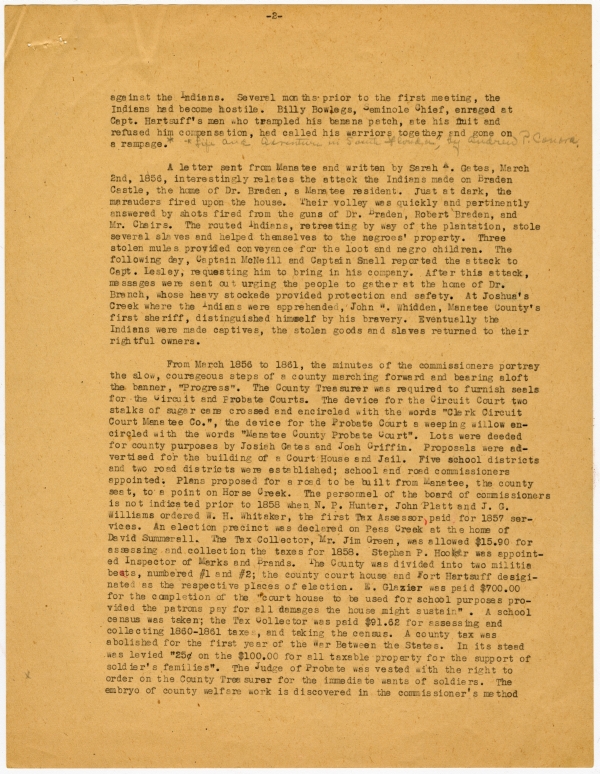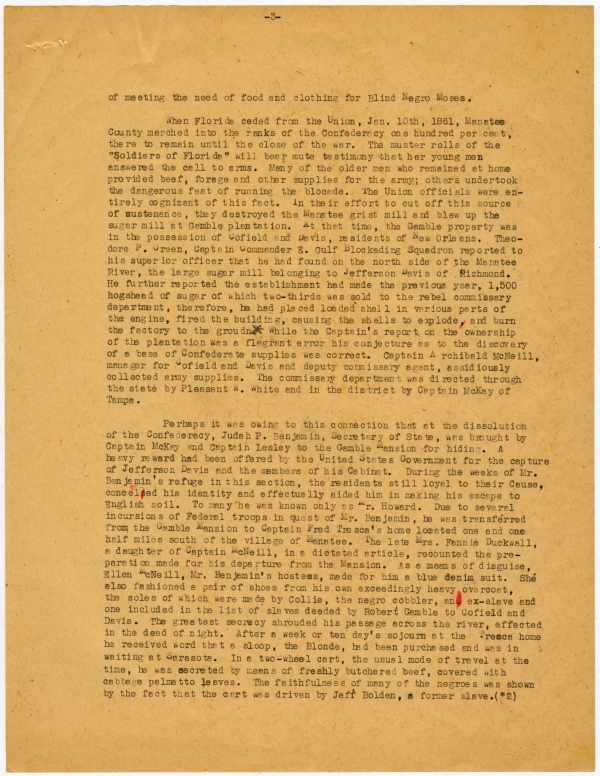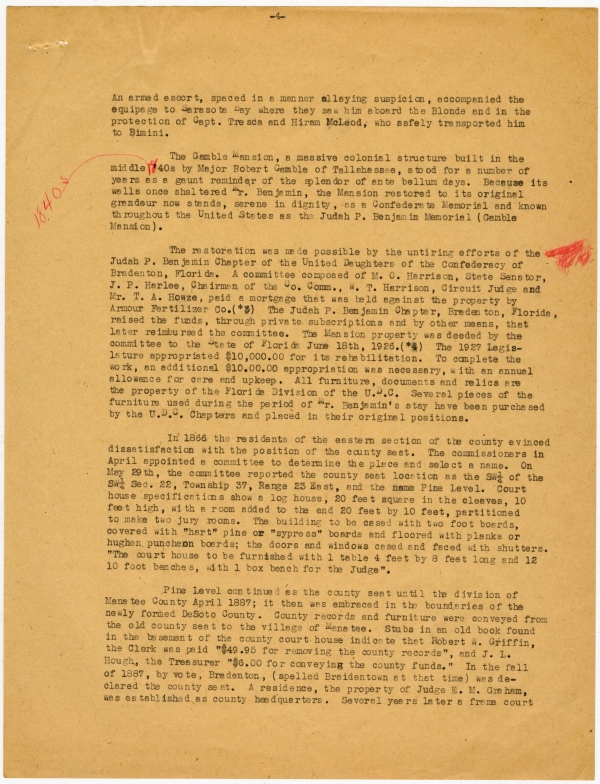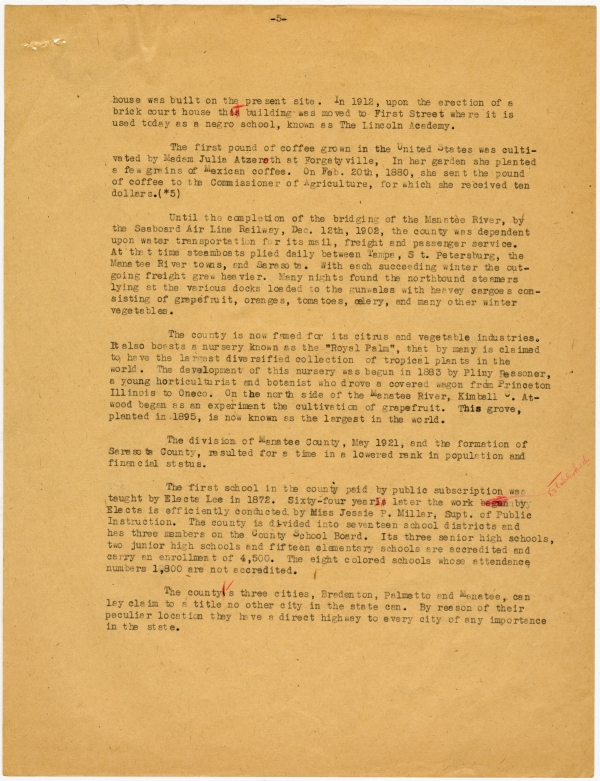Transcript
HISTORICAL SKETCH OF MANATEE COUNTY
Manatee County was created by an Act of the Legislature, Jan. 9th, 1855. Prior to the passage of this measure, the area now called Manatee County had been included within the boundaries of Alachua and Hillsborough Counties. On page 283 of John P. Duval's "Compilation of the Public Acts of the Legislative Council of the Territory of Florida, Passed Prior to 1840", one finds the boundaries of Alachua very definitely set forth. The line comprehending this vast tract began at the Suwannee on the west, touched, on the north, the line dividing the Territory of Florida and the State of Georgia. At the head of the river St Mary's, by devious route, it ambled south to the main road from Tallahassee, missed the banks of the St. Johns by eight miles, veered west and south by the way of the Ocklawaha river and the Indian boundary line to the waters of Charlotte Harbor and then ran "west and north along the shores of the Gulf of Mexico, including the islands to the mouth of the river Suwanhee [sic]". The approval of the act to organize a county called Hillsborough, January 25th, 1834, is also found on page 292.
The original boundaries of Manatee County extended from the Gulf of Mexico to Lake Okeechobee; they embraced an area of 5,000 square miles and included a tract 60 miles or more in width from north to south.(*1)
It is intriguing to imagine the method of procedure adopted by the pioneers who, sturdy of heart and long of vision, undertook the problems of organizing and administering the county's affairs. Early records of Manatee County have been well preserved, therefore, one is not left to flounder long in his own imaginings. In case he wishes to know, he will reach high on a shelf in the county commissioner's store room, lift down a volume, dusty, small, and entitled "Minutes of the County Commissioners", turn its pages and become well acquainted with the doings of the first county officials. The county government apparently did not begin to function until the year 1856; other than the transcriptions of Hillsboro records the earliest available records bear that date.
The faithful "Minutes", accurately and diligently recorded, indicate the first meeting of the commissioners under date of March 10th, 1856. The bonds of E. Glazier, Judge of Probate and James Cunliff, coroner, were approved. The Clerk of Manatee County was authorized to call on the Clerk of Hillsboro for matters on record pertaining to matters of Manatee County. Edmund Lee, the Clerk, was granted permission to use his books for record until others were furnished him. Josiah Gates, the first Manatee settler to receive a grant of land issued under the Armed Occupation Act, was appointed County Treasurer. No county tax was levied for 1856.
The commissioners held yearly meetings. During that period it behooved each man to remain close at home in order to protect his family
-2-
against the Indians. Several months prior to the first meeting, the Indians had become hostile. Billy Bowlegs, Seminole Chief, enraged at Capt. Hartsuff's men who trampled his banana patch, ate his fruit and refused him compensation, had called his warriors together and gone on a rampage. *"Life and Adventure in South Florida," by Andrew P. Canova.
A letter sent from Manatee and written by Sarah A. Gates, March 2nd, 1856, interestingly relates the attack the Indians made on Braden Castle, the home of Dr. Braden, a Manatee resident. Just at dark, the marauders fired upon the house. Their volley was quickly and pertinently answered by shots fired from the guns of Dr. Braden, Robert Braden, and Mr. Chairs. The routed Indians, retreating by way of the plantation, stole several slaves and helped themselves to negroes' property. Three stolen mules provided conveyance for the loot and negro children. The following day, Captain McNeill and Captain Snell reported the attack to Capt. Lesley, requesting him to bring in his company. After this attack, messages were sent out urging the people to gather at the home of Dr. Branch, whose heavy stockade provided protection and safety. At Joshua's Creek where the Indians were apprehended, John W. Whidden, Manatee County's first sheriff, distinguished himself by his bravery. Eventually the Indians were made captives, the stolen goods and slaves returned to their rightful owners.
From March 1856 to 1861, the minutes of the commissioners portray the slow, courageous steps of a county marching forward and bearing aloft the banner, "Progress". The County Treasurer was required to furnish seals for the Circuit and Probate Courts. The device for the Circuit Court two stalks of sugar cane crossed and encircled with the words "Clerk Circuit Court Manatee Co.", the device for the Probate Court a weeping willow encircled with the words "Manatee County Probate Court". Lots were deeded for county purposes by Josiah Gates and Joah Griffin. Proposals were advertised for the building of a Court House and Jail. Five school districts and two road districts were established; school and road commissioners appointed. Plans proposed for a road to be built from Manatee, the county seat, to a point on Horse Creek. The personnel of the board of commissioners is not indicated prior to 1858 when N. P. Hunter, John Platt and J. G. Williams ordered W. H. Whitaker, the first Tax Assessor, paid for 1857 services. An election precinct was declared on Peas Creek at the home of David Summerall. The Tax Collector, Mr. Jim Green, was allowed $15.90 for assessing and collection the taxes for 1858 [sic]. Stephen P. Hooker was appointed Inspector of Marks and Brands. The County was divided into two militia beats, numbered #1 and #2; the county court house and Fort Hartsuff [designated] as the respective places of election. E. Glazier was paid $700.00 for the completion of the "court house to be used for school purposes provided the patrons pay for all damages the house might sustain". A school census was taken; the Tax Collector was paid $91.62 for assessing and collecting 1860-1861 taxes, and taking the census. A county tax was abolished for the first year of the War Between the States. In its stead was levied "25¢ on the $100.00 for all taxable property for the support of soldier's families". The Judge of Probate was vested with the right to order on the County Treasurer for the immediate wants of soldiers. The embryo of county welfare work is discovered in the commissioner's method
-3-
of meeting the need of food and clothing for Blind Negro Moses.
When Florida ceded from the Union, Jan. 10th, 1861, Manatee County marched into the ranks of the Confederacy one hundred per cent, there to remain until the close of the war. The muster rolls of the "Soldiers of Florida" will bear mute testimony that her young men answered the call to arms. Many of the older men who remained at home provided beef, forage and other supplies for the army; others undertook the dangerous feat of running the [blockade]. The Union officials were entirely cognizant of this fact. In their effort to cut off this source of sustenance, they destroyed the Manatee grist mill and blew up the sugar mill at Gamble plantation. At that time, the Gamble property was in the possession of Cofield and Davis, residents of New Orleans. Theodore P. Green, Captain Commander E. Gulf Blockading Squadron reported to his superior officer that he had found on the north side of the Manatee River, the large sugar mill belonging to Jefferson Davis of Richmond. He further reported the establishment had made the previous year, 1,500 hogshead of sugar of which two-thirds was sold to the rebel commissary department, therefore, he had placed loaded shell in various parts of the engine, fired the building, causing the shells to explode and burn the factory to the [ground]. While the Captain's report on the ownership of the plantation was a flagrant error his conjecture as to the discovery of a base of Confederate supplies was correct. Captain Archibald McNeill, manager for Cofield and Davis and deputy commissary agent, assidiously collected army supplies. The commissary department was directed through the state by Pleasant W. White and in the district by Captain McKay of Tampa.
Perhaps it was owing to this connection that at the dissolution of the Confederacy, Judah P. Benjamin, Secretary of State, was brought by Captain McKay and Captain Lesley to the Gamble Mansion for hiding. A heavy reward had been offered by the United States Government for the capture of Jefferson Davis and the members of his Cabinet. During the weeks of Mr. Benjamin's refuge in this section, the residents still loyal to their Cause, concealed his identity and effectually aided him in making his escape to English soil. To many he was known only as Mr. Howard. Due to several incursions of Federal troops in quest of Mr. Benjamin, he was transferred from the Gamble Mansion to Captain Fred Tresca's home located one and one half miles south of the village of Manatee. The late Mrs. Fannie Duckwall, a daughter of Captain McNeill, in a dictated article, recounted the preparation made for his departure from the Mansion. As a means of disguise, Ellen McNeill, Mr. Benjamin's hostess, made for him a blue denim suit. She also fashioned a pair of shoes from his own exceedingly heavy overcoat, the soles of which were made by Collie, the negro cobbler, an ex-slave and one included in the list of slaves deeded by Robert Gamble to Cofield and Davis. The greatest secrecy shrouded his passage across the river, effected in the dead of night. After a week or ten day's sojourn at the Tresca home he received word that a sloop, the Blonde, had been purchased and was in waiting at Sarasota. In a two-wheel cart, the usual mode of travel at the time, he was secreted by means of freshly butchered beef, covered with cabbage palmetto leaves. The faithfulness of many of the negroes was shown by the fact that the cart was driven by Jeff Bolden, a former slave.(*2)
-4-
An armed escort, spaced in a manner allaying suspicion, accompanied the equipage to Sarasota Bay where they saw him aboard the Blonde and in the protection of Capt. Tresca and Hiram McLeod, who safely transported him to Bimini.
The Gamble Mansion, a massive colonial structure built in the middle 1840s by Major Robert Gamble of Tallahassee, stood for a number of years as a gaunt reminder of the splendor of ante bellum days. Because its walls once sheltered Mr. Benjamin, the Mansion restored to its original grandeur now stands, serene in dignity, as a Confederate Memorial and known throughout the United States as the Judah P. Benjamin Memorial (Gamble Mansion).
The restoration was made possible by the untiring efforts of the Judah P. Benjamin Chapter of the United Daughters of the Confederacy of Bradenton, Florida. A committee composed of M. O. Harrison, State Senator, J. P. Harlee, Chairman of the Co. Comm., W. T. Harrison, Circuit Judge and Mr. T. A. Howze, paid a mortgage that was held against the property by Armour Fertilizer Co.(*3) The Judah P. Benjamin Chapter, Bradenton, Florida, raised the funds, through private subscriptions and by other means, that later reimbursed the committee. The Mansion property was deeded by the committee to the State of Florida June 18th, 1926.(*4) The 1927 Legislature appropriated $10,000.00 for its rehabilitation. To complete the work, an additional $10.00.00 appropriation was necessary, with an annual allowance for care and upkeep. All furniture, documents and relics are the property of the Florida Division of the U. D. C. Several pieces of the furniture used during the period of Mr. Benjamin's stay have been purchased by the U. D. C. Chapters and placed in their original positions.
In 1866 the residents of the eastern section of the county evinced dissatisfaction with the position of the county seat. The commissioners in April appointed a committee to determine the place and select a name. On May 29th, the committee reported the county seat location as the SW 1/4 of the SW 1/4 Sec. 22, Township 37, Range 23 East, and the name Pine Level. Court house specifications show a log house, 20 feet square in the cleaves, 10 feet high, with a room added to the end 20 feet by 10 feet, partitioned to make two jury rooms. The building to be cased with two foot boards, covered with "hart" pine or "[cypress]"boards and floored with planks or hughen pucheon boards; the doors and windows cased and faced with shutters. "The court house to be furnished with 1 table 4 feet by 8 feet long and 12 10 foot benches, with 1 box bench for the Judge".
Pine Level continued as the county seat until the division of Manatee County April 1887; it then was embraced in the boundaries of the newly formed DeSoto County. County records and furniture were conveyed from the old county seat to the village of Manatee. Stubs in an old book found in the basement of the county court house indicate that Robert W. Griffin, the Clerk was paid "$49.95 for removing the county records", and J. L. Hough, the Treasurer "$6.00 for conveying the county funds." In the fall of 1887, by vote, Bradenton, (spelled Braidentown at that time) was declared the county seat. A residence, the property of Judge E. M. Graham, was established as county headquarters. Several years later a frame court
-5-
house was built on the present site. In 1912, upon the erection of a brick court house that building was moved to First Street where it is used today as a negro school, known as The Lincoln Acadamy.
The first pound of coffee grown in the United States was cultivated by Madam Julia Atzeroth at Forgatyville, In her garden she planted a few grains of Mexican coffee. On Feb. 20th, 1880, she sent the pound of coffee to the Commissioner of Agriculture, for which she received ten dollars.(*5)
Until the completion of the bridging of the Manatee River, by the Seaboard Air Line Railway, Dec. 12th, 1902, the county was dependent upon water transportation for its mail, freight and passenger service. At that time steamboats plied daily between Tampa, St. Petersburg, the Manatee River towns, and Sarasota. With each succeeding winter the outgoing freight grew heavier. Many nights found the northbound steamers lying at the various docks loaded to the gunwales with [heavy] cargoes consisting of grapefruit, oranges, tomatoes, celery, and many other winter vegetables.
The county is now famed for its citrus and vegetable industries. It also boasts a nursery known as the "Royal Palm", that by many is claimed to have the largest diversified collection of tropical plants in the world. The development of this nursery was begun in 1883 by Pliny Peasoner, a young horticulturist and botanist who drove a covered wagon from Princeton[,] Illinois to Oneco. On the north side of the Manatee River, Kimball C. At- wood began as an experiment the cultivation of grapefruit. This grove, planted in 1895, is now known as the largest in the world.
The division of Manatee County, May 1921, and the formation of Sarasota County, resulted for a time in a lowered rank in population and financial status.
The first school in the county paid by public subscription was taught by Electa Lee in 1872. Sixty-four years later the work established by Electa is efficiently conducted by Miss Jessie P. Miller, Supt. of Public Instruction. The county is divided into seventeen school districts and has three members on the County School Board. Its three senior high schools, two junior high schools and fifteen elementary schools are accredited and carry an enrollment of 4,500. The eight colored schools whose attendance numbers 1,800 are not accredited.
The county's three cities, Bradenton, Palmetto and Manatee, can lay claim to a title no other city in the state can. By reason of their peculiar location they have a direct highway to every city of any importance in the state.

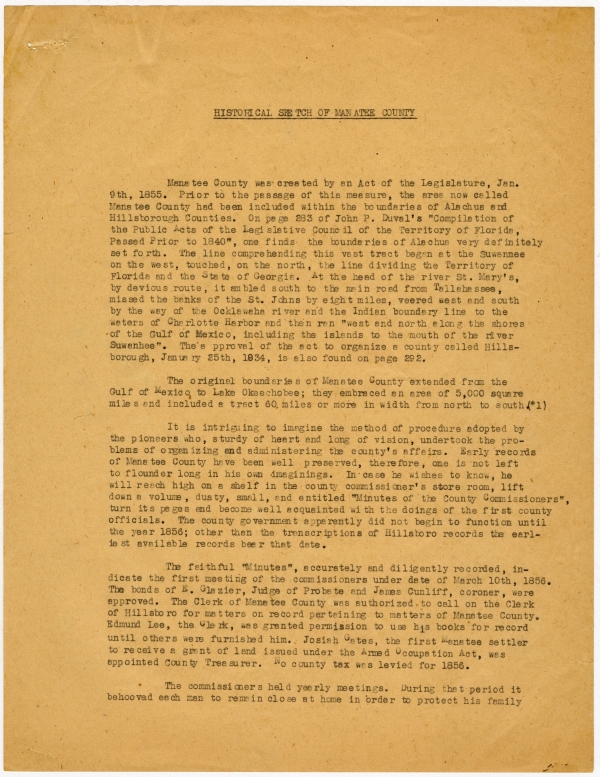


 Listen: The Folk Program
Listen: The Folk Program